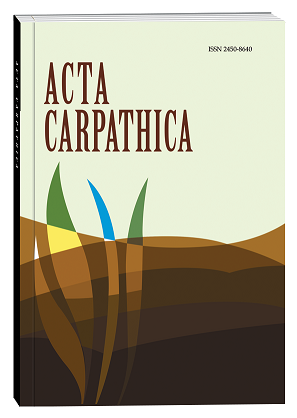DENDROINDICATION OF THE ENVIRONMENTAL STATE OF TECHNOLOGICAL TERRITORIES IN THE VICINITY OF BURSHTYNSKA THERMAL POWER STATION
DOI:
https://doi.org/10.32782/2450-8640.2022.2.10Keywords:
technogenic pollution, toxic effect, trees, bushes, deformations of shoots, deformations of leaf plates, necrosis of leaf platesAbstract
Burshtyn thermal power plant negatively impacts the environment, particularly on trees and bushes filtering dust containing toxic substances. The latter precipitate on the leaf plate surfaces, causing various necrosis diseases, leading to many plants’ death. And only fairly enduring plant species adapt to such environmental conditions and continue to exist. The research results make it possible to introduce sustainable woody reclamants of the environment, as well as woody indicators of its environmental state when foresting adjacent areas of the Burshtyn thermal power plant contaminated with chemical elements. It was found that the species diversity of shrubs and trees is represented by only 8 species (Populus nigra L., P. tremula L., Salix caprea L., S. Alba L., Betula pendula L., Sambucus nigra L., Prunus spinosa L., Tilia cordata Mill.). Within a radius of up to 0,5 km2 of the Burshtyn thermal power plant. Deformations of shoots were found in 75% of trees and bushes, and deformations of leafy plates were found in 100% of species. The species growing in the adjacent territory is attributed to finely deciduous wooden trees alongside and are characterized by a wide amplitude of adaptive and natural adaptations. In a remote area (from 0,5 to 1 km2) from the Burshtyn thermal power plant, the species diversity of shrub-tree vegetation is much more diverse and represented by 20 species (Acer campestre L., A.platanoides L., A. negundo L., A. platanoides L., Fraxinus excelsior L., F. Lanceolata Borkh., Populus nigra L., P. tremula L., Salix caprea L., S. alba L., Betyla pendula L., Carpinus betulus L., Sambucus nigra L., Tilia cordata Mill., Quercus robur L., Fagus sylvatica L., Crataegus oxyacantha L., Prunus spinosa L., Robinia seudoacacia L., Gleditsia triacanthos L.). Deformations of shoots were found in 35% of trees and bushes, and deformations of leaf plates in 100% of species. However, their intensity is much less and less pronounced. The species of both fine- and broad-leaved plants characteristic of this area are concentrated here.
References
Аналіз радіаційної обстановки в зоні техногенного впливу Бурштинської ТЕС. URL: http://medradiologia.org.ua/assets/files/arch (дата звернення: 16.11. 2022).
Миленька М.М. Біоіндикаційна оцінка екологічного стану Бурштинської урбоекосистеми. Екологічний вісник. 2016. № 1. С. 19–22.
Tree bark as a bioindicator of air pollution in the city of Stassfurt, Saxony-An-halt, Germany /M. Birke et al. Journal of Geochemical Exploration. 2018. 187. С. 97–117.
Erofeeva E.A. Hormesis and Paradoxical Effects of Drooping Birch (Betula pendula Roth) Parameters Under Motor Traffic Pollution. Dose Response. 2015.13 (2). URL: https://www.researchgate.net/publication/277930697 (дата звернення: 22.11.2022).
Оцінювання впливу Бурштинської ТЕС на атмосферне повітря / Y.I. Pankivskyi et al. Науковий вісник Національного лісотехнічного університету України. 2017. № 27 (5). C. 59–62.








